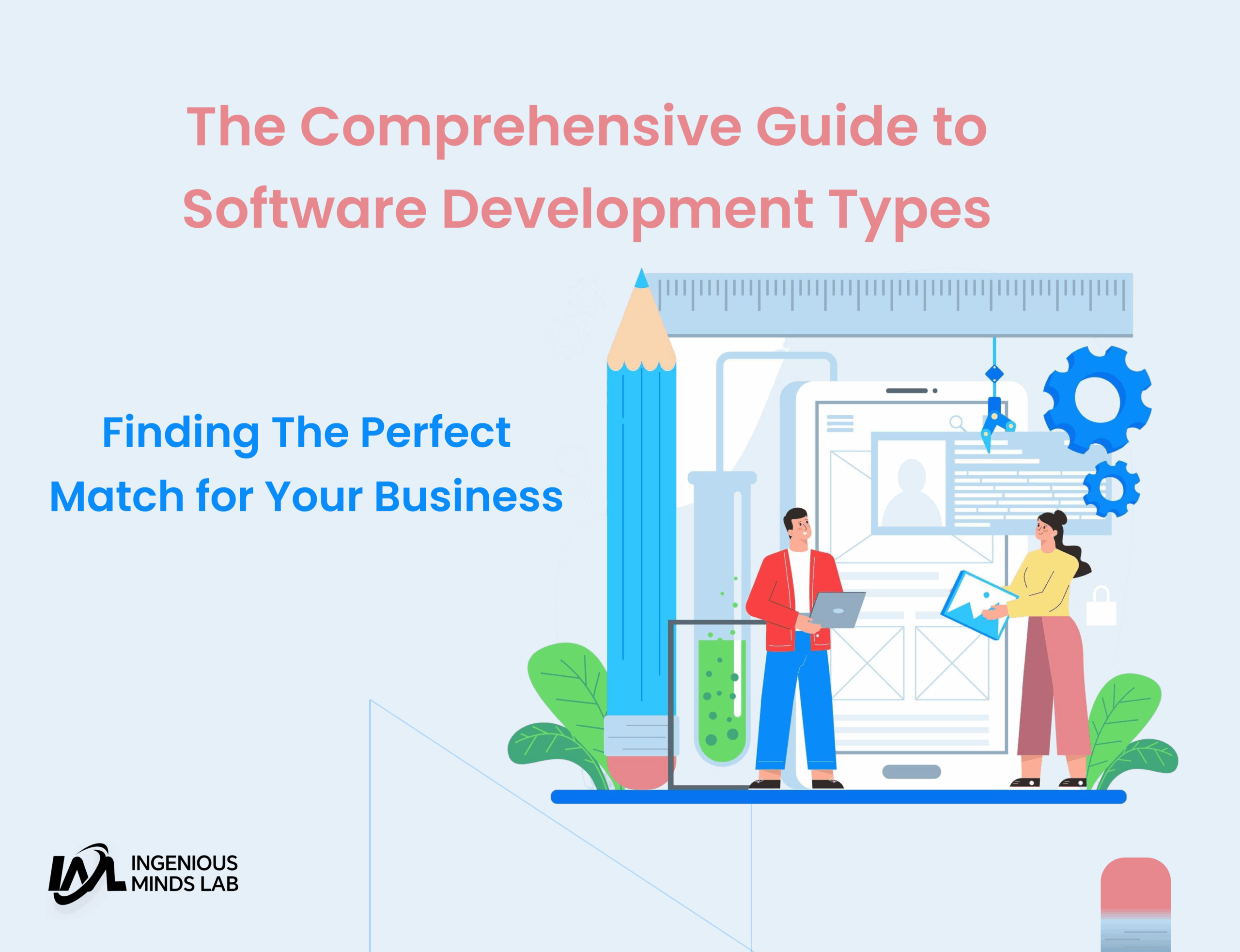In today’s digital landscape, choosing the right type of software development can make or break your business strategy. With technology evolving at breakneck speed, understanding the diverse approaches to software development has never been more crucial for staying competitive and innovative.
This guide explores the multifaceted world of software development, breaking down the various types by platform, methodology, and underlying technology. Whether you’re a startup looking to launch your first digital product or an established enterprise seeking digital transformation, this roadmap will help you navigate the complex terrain of software development options.
Software Development Categories: A Strategic Overview
Software development isn’t one-size-fits-all. The approach that powers a banking application differs dramatically from what drives a smart home device or an e-commerce platform. Let’s explore how software development varies across key dimensions and how each type serves different business objectives.
Platform-Based Software Development
The device or platform where your software will run fundamentally shapes its development requirements, architecture, and capabilities.
Desktop Applications
Desktop applications are installed directly on computers, leveraging local processing power for complex operations.
Key Characteristics:
- High performance for resource-intensive tasks
- Platform-specific development (Windows, macOS, Linux)
- Rich functionality without constant internet connectivity
- Ideal for complex processing tasks like video editing and 3D modeling
Business Applications : Financial analysis tools, professional creative suites, enterprise management systems
Examples: Microsoft Excel, Adobe Premiere Pro, AutoCAD
Mobile Applications
Mobile apps are designed specifically for smartphones and tablets, prioritizing touch interfaces and on-the-go functionality.
Key Advantages:
- Direct access to device features (camera, GPS, biometrics)
- Distribution through established app marketplaces
- Engagement through push notifications and mobile-first design
- Cross-platform development options (native, hybrid, or progressive)
Business Applications: Field service management, retail point-of-sale, customer loyalty programs
Examples: Uber, Microsoft Outlook, Shopify
Web Applications
Web applications run in browsers without installation, offering cross-platform accessibility and centralized updates.
Key Benefits:
- Universal access across devices and operating systems
- Centralized deployment and instant updates
- No installation required for end-users
- Seamless integration with other web services
Business Applications: Customer relationship management, content management systems, collaboration tools
Examples: Google Workspace, Salesforce, WordPress
Embedded Systems
Embedded software powers dedicated hardware devices, from industrial equipment to consumer electronics.
Key Strengths:
- Optimized for specific hardware configurations
- Real-time processing capabilities
- Minimal resource consumption
- Long-term reliability and stability
Business Applications: Manufacturing automation, medical devices, automotive systems
Examples: Smart thermostats, point-of-sale terminals, industrial controllers
Cloud-Based Solutions
Cloud software leverages remote infrastructure for processing, storage, and scalability.
Key Advantages:
- Elastic scalability to match demand
- Reduced infrastructure management
- Subscription-based pricing models
- Continuous deployment and updates
Business Applications: Enterprise resource planning, data analytics platforms, collaboration suites
Examples: Microsoft Azure services, Amazon Web Services applications, Dropbox
Development Approach Classifications
The methodology behind software creation significantly impacts its flexibility, maintenance, and business alignment.
System Software
System software manages hardware resources and provides platforms for other applications to run.
Key Features:
- Low-level hardware interaction
- Resource optimization
- Security and stability focus
- Foundation for application ecosystems
Business Applications: Infrastructure management, virtualization, security frameworks
Examples: VMware ESXi, Windows Server, Linux distributions
Application Software
Application software addresses specific user needs and business functions.
Key Benefits:
- User-centric design
- Focused functionality
- Intuitive interfaces
- Task-specific optimization
Business Applications: Productivity tools, communication platforms, specialized business functions
Examples: Slack, QuickBooks, Trello
Enterprise Software
Enterprise software integrates and manages organization-wide processes and data.
Key Advantages:
- Cross-departmental integration
- Centralized data management
- Workflow automation
- Compliance and security features
Business Applications: Supply chain management, human resources information systems, enterprise resource planning
Examples: SAP, Oracle ERP, Workday
Custom Software
Custom software is built specifically for unique business requirements that off-the-shelf solutions can’t address.
Key Benefits:
- Tailored to exact business processes
- Competitive differentiation
- Ownership of intellectual property
- Precise integration with existing systems
Business Applications: Proprietary workflows, industry-specific solutions, unique business models
Examples: Custom banking platforms, specialized healthcare systems, proprietary trading algorithms
Open-Source Software
Open-source software provides transparent, community-developed solutions with accessible source code.
Key Advantages:
- Transparency and auditability
- Community-driven innovation
- Cost efficiency
- Flexibility and customization
Business Applications: Development tools, infrastructure components, content management
Examples: Linux, WordPress, PostgreSQL
Proprietary Software
Proprietary software offers commercially developed solutions with controlled distribution and support.
Key Strengths:
- Professional support and service level agreement
- Consistent update cycles
- Integrated ecosystems
- Specialized industry solutions
Business Applications: Professional creative tools, specialized industry software, enterprise platforms
Examples: Microsoft Office, Adobe Creative Cloud, Salesforce
Technology-Driven Categories
The underlying technologies and architectural approaches define software’s capabilities, performance, and future-readiness.
Front-End Development
Front-end development creates the user interfaces and experiences that directly engage users.
Key Features:
- Responsive design across devices
- Interactive user interfaces
- Visual consistency and branding
- Accessibility compliance
Business Applications: E-commerce storefronts, customer portals, content presentation
Examples: Corporate websites, web applications, interactive dashboards
Back-End Development
Back-end development builds the server-side systems that process data and business logic.
Key Strengths:
- Data processing and storage
- Business rule implementation
- API development
- System integration
Business Applications: Payment processing, inventory management, user authentication
Examples: Database systems, authentication services, business logic processors
Full-Stack Solutions
Full-stack development combines front-end and back-end expertise for end-to-end application creation.
Key Benefits:
- Unified development approach
- Seamless data flow
- Consistent user experience
- Efficient development cycles
Business Applications: Complete web applications, SaaS platforms, digital products
Examples: E-learning platforms, social networks, booking systems
AI and Machine Learning Systems
AI-powered software leverages data patterns to enable prediction, automation, and intelligent decision-making.
Key Advantages:
- Predictive capabilities
- Process automation
- Personalization
- Continuous improvement through learning
Business Applications: Customer insights, process optimization, predictive maintenance
Examples: Recommendation engines, fraud detection systems, predictive analytics platforms
Blockchain Applications
Blockchain software provides decentralized, transparent, and secure transaction systems.
Key Features:
- Immutable record-keeping
- Decentralized verification
- Smart contract automation
- Enhanced security
Business Applications: Supply chain tracking, digital identity verification, secure transactions
Examples: Cryptocurrency wallets, supply chain verification systems, smart contract platforms
Cybersecurity Solutions
Cybersecurity software protects systems, networks, and data from digital threats.
Key Strengths:
- Threat detection and prevention
- Compliance enforcement
- Data protection
- Risk management
Business Applications: Network security, data protection, compliance management
Examples: Endpoint protection, network monitoring, identity management systems
Big Data and Analytics Platforms
Big data software processes and analyzes large volumes of information to extract actionable insights.
Key Benefits:
- Pattern recognition in large datasets
- Business intelligence generation
- Data visualization
- informed decision support
Business Applications: Customer behavior analysis, operational optimization, market research
Examples: Business intelligence dashboards, predictive analytics tools, data visualization platforms
Making the Right Choice for Your Business
Selecting the optimal software development approach requires careful consideration of your business objectives, resources, and long-term strategy. Here are key factors to evaluate:
- Business Requirements: Identify your specific needs, workflows, and pain points
- User Experience: Consider how your customers or employees will interact with the software
- Scalability Needs: Anticipate future growth and changing demands
- Integration Requirements: Assess how new software will connect with existing systems
- Budget Constraints: Balance immediate costs against long-term value
- Timeline Considerations: Determine your implementation urgency
- Maintenance Capacity: Evaluate your ability to support and update the software
The Future of Software Development
As technology continues to evolve, software development is increasingly characterized by:
- Convergence of approaches: Hybrid solutions combining multiple development types
- Low-code and no-code platforms: Democratizing software creation
- AI-assisted development: Automating routine coding tasks
- Edge computing integration: Bringing processing closer to data sources
- Sustainability considerations: Optimizing for energy efficiency and environmental impact
By understanding these diverse software development approaches and their strategic applications, businesses can make informed decisions that drive innovation, efficiency, and competitive advantage in an increasingly digital marketplace.
Frequently Asked Questions
What is the software development life cycle (SDLC)?
The SDLC is a structured process for planning, creating, testing, and deploying software. It typically includes phases such as requirements gathering, design, implementation, testing, deployment, and maintenance, following methodologies like Agile, Waterfall, or DevOps to ensure quality and efficiency.
How do I know if I need custom software or if an off-the-shelf solution will work?
Consider custom software when your business processes are unique, when you need tight integration with existing systems, when you require specific features not available in commercial products, or when you want to create a competitive advantage through proprietary technology. Off-the-shelf solutions are typically more cost-effective for standard business functions that don’t require customization.
What’s the difference between native, hybrid, and progressive web apps?
Native apps are built specifically for one platform (iOS or Android) using platform-specific languages, offering optimal performance and access to all device features. Hybrid apps use web technologies wrapped in a native container, allowing cross-platform deployment with a single codebase but sometimes with performance compromises. Progressive web apps (PWAs) are web applications that offer app-like experiences through browsers, with features like offline functionality and home screen installation.
How does cloud-based software development differ from traditional approaches?
Cloud-based development leverages remote infrastructure for development, testing, and deployment, enabling greater scalability, collaboration, and continuous delivery. Traditional approaches rely more on local infrastructure and often follow more sequential development processes. Cloud development typically embraces microservices architecture, containerization, and DevOps practices for faster iteration and deployment.
What role does artificial intelligence play in modern software development?
AI enhances software development through automated code generation, intelligent testing, predictive analytics for project management, and automated bug detection. In finished products, AI enables features like natural language processing, recommendation systems, predictive analytics, computer vision, and intelligent automation, creating more intuitive and adaptive user experiences.

